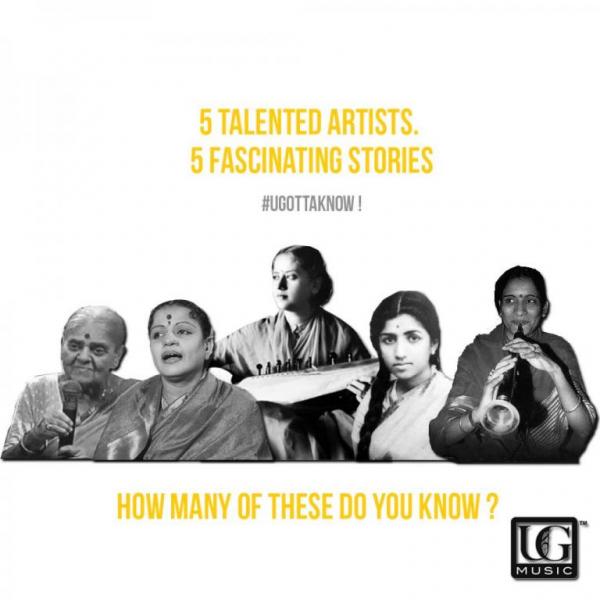- Mar 08 Mar, 2017
- Master Musicians, Pioneers of Music
Today, in a special edition of Master Musicians, we celebrate the five women pioneers of music in India !
[ Image: From left to right : Rajkumari Dubey, Madurai Shanmukhavadivu Subbulakshmi, Sharan Rani Backliwal, Lata Dinanath Mangeshkar, Bageshwari Qamar]
The first woman playback singer of India
Rajkumari Dubey (1924–2000), better known by her first name, Rajkumari, was an Indian playback singer who worked in Hindi cinema in the 1930s and 1940s. Best known for her songs, "Sun Bairi Baalam Sach Bol Re" in Bawre Nain (1950), "Ghabrekar Ke Jo Hum Sir Ko Takraayan" in Mahal (1949) and "Najariya Ki Maari" in Pakeezah (1972).
Born in Benaras (Varanasi), She joined the Hindi cinema at age 11, as a child actor in Radhe Shyam aur Zulmi Hans (1932), thereafter she worked in theatre for few years, before returning to films, joining Prakash Pictures as actor and singer. She had much higher voice than the leading singers of time, Zohrabai Ambalewali, Amirbai Karnataki and Shamshad Begum. In the next two decades she sang for 100 films, till early 1950s and slowly retired to make way for the “new girl” who was, Lata Mangeshkar.
The first musician to be awarded the Bharat Ratna
Madurai Shanmukhavadivu Subbulakshmi (16 September 1916 – 11 December 2004), also known as M.S., was a Carnatic vocalist. She was the first musician ever to be awarded the Bharat Ratna, India's highest civilian honour. She is the first Indian musician to receive the Ramon Magsaysay award, often considered Asia's Nobel Prize, in 1974 with the citation reading "Exacting purists acknowledge Srimati M. S. Subbulakshmi as the leading exponent of classical and semi-classical songs in the carnatic tradition of South India."
Pandit Jawaharlal Nehru famously said "Who am I, a mere Prime Minister before a Queen, a Queen of Music" as he praised her. While Lata Mangeshkar called her Tapaswini (the Renunciate), Ustad Bade Ghulam Ali Khan termed her Suswaralakshmi (the goddess of the perfect note), and Kishori Amonkar labelled her the ultimate eighth note or Aathuvaan Sur, which is above the seven notes basic to all music.
The first Indian woman to play the Sarod
Sharan Rani Backliwal (née Mathur) was an Indian classical instrumentalist and music scholar, best known for her expertise with the sarod.
Her private collection of 370 musical instruments ranging from the 15th to the 19th century are now part of the "Sharan Rani Backliwal Gallery of Musical Instruments" at the National Museum, New Delhi.
She was born Sharan Rani Mathur in Walled city of Old Delhi to a conservative Hindu family of well-known businessmen and educationists. As a young girl, Sharan Rani learned to play the sarod from the master musicians Allauddin Khan and his son Ali Akbar Khan. During this period in Indian history, a career as a musician was seen as something for gharanas (families where music was a hereditary profession) or was the profession of nautch girls or baijis, not something appropriate for the daughter of a respectable, non-musician family. She also learned the Kathak form of classical Indian dance from Achhan Maharaj and Manipuri dance from Nabha Kumar Sinha. In 1953, she did her M.A from Delhi University, and studied at Indraprastha College for Women.
From the late 1930s, Sharan Rani presented her sarod recitals on the concert stage in India for over seven decades, receiving unprecedented critical acclaim. Since the 1950s she presented her sarod recitals abroad becoming the very first musician from India to go to many countries in all the continents. She played a vital role in introducing and popularizing Indian classical music abroad. She was one of the very first to record for UNESCO and to release musical recordings with major record companies in the United States, Britain and France.
On the concert stage for over seven decades, many of her sarod recitals were graced by Presidents, Prime Ministers, Kings and Queens, and Heads of State of many countries. She performed at major music halls around the world and in many major music conferences in India. She gave many lecture demonstrations in India and abroad. She had a special fondness for children and young adults and always took out time to give special concerts and lec-dems, free of charge for them. She never turned down a request for a laudable cause and gave many benefit performances for charitable and worthy causes.
The first Indian woman Playback singer to have sung over 30000 songs.
Lata Dinanath Mangeshkar is an Indian playback singer, and occasional music-composer. She is one of the best-known and most respected playback singers in India. Mangeshkar's career started in 1942 and has spanned over seven decades. She has recorded songs for over a thousand Hindi films and has sung songs in over thirty-six regional Indian languages and foreign languages, though primarily in Marathi and Hindi. India's highest award in cinema, the Dadasaheb Phalke Award, was bestowed on her in 1989 by the Government of India. She is the second vocalist, after M. S. Subbulakshmi, to have ever been awarded the Bharat Ratna, India's highest civilian honour. And the rest is history.
The first woman Shehnai Player of India
Bageshwari Qamar is the first woman Shehnai player of India. Bageshwari Qamar learnt Shehnai from Ustad Bismillah Khan. She was crowned Shehnai Queen at Chandigarh in 1983, the year she made her debut. Bageshwari has recorded a jugalbandi with Ustad Bismillah Khan apart from solo cassettes. She represented India at the Bharat Mahotsav at Russia in 1988.
Bageshwari Qamar is the daughter of Jagdish Prasad Qamar, the only disciple of Ustad Bismillah Khan, who joined him as per the traditional Gurukul system. Jagdish joined Ustad Bismillah Khan at the age of 10 in 1946. He lived and learned shehnai at the Ustad's house in Benaras.
Sources : www.wikipedia.com, http://www.thecolorsofindia.com











